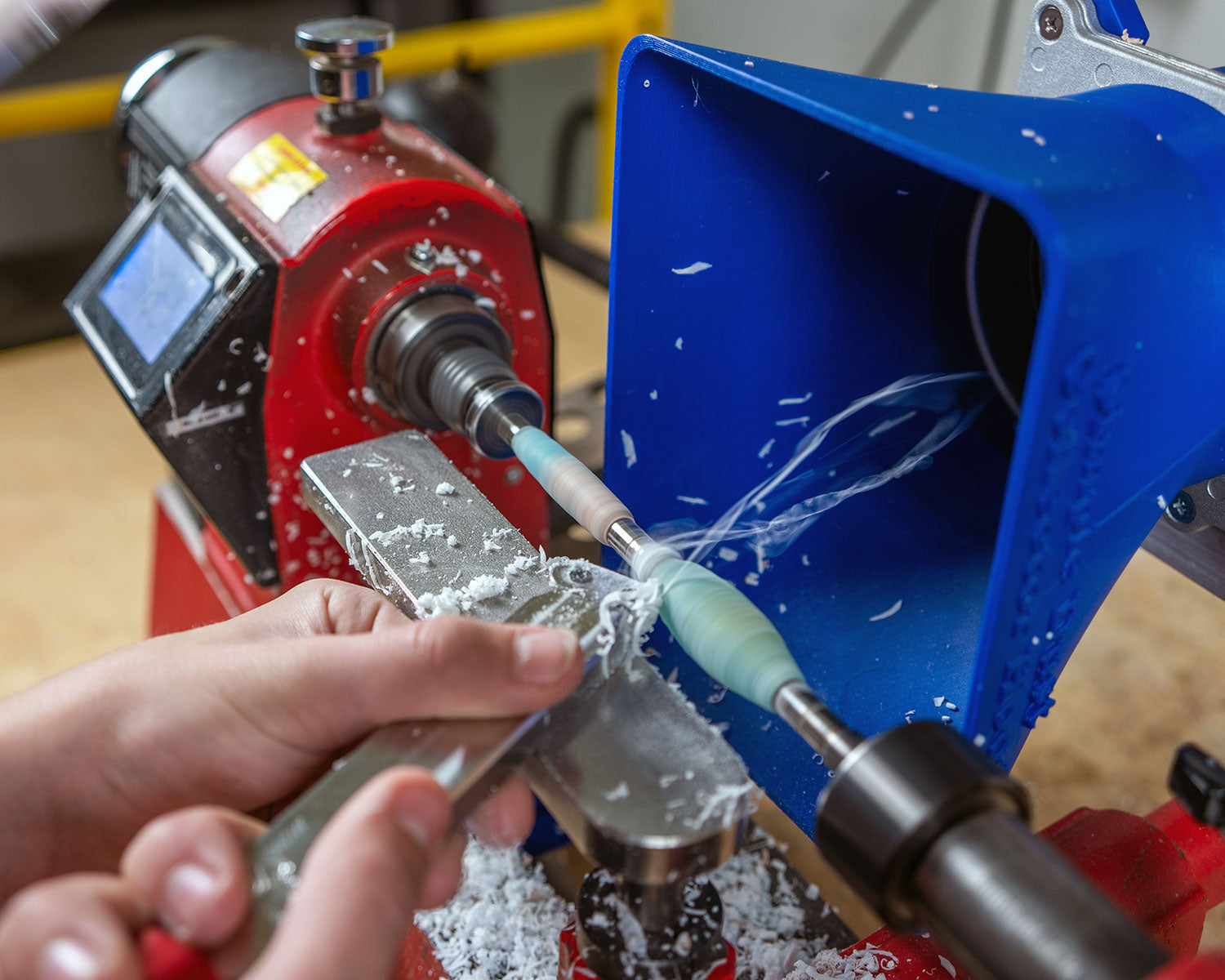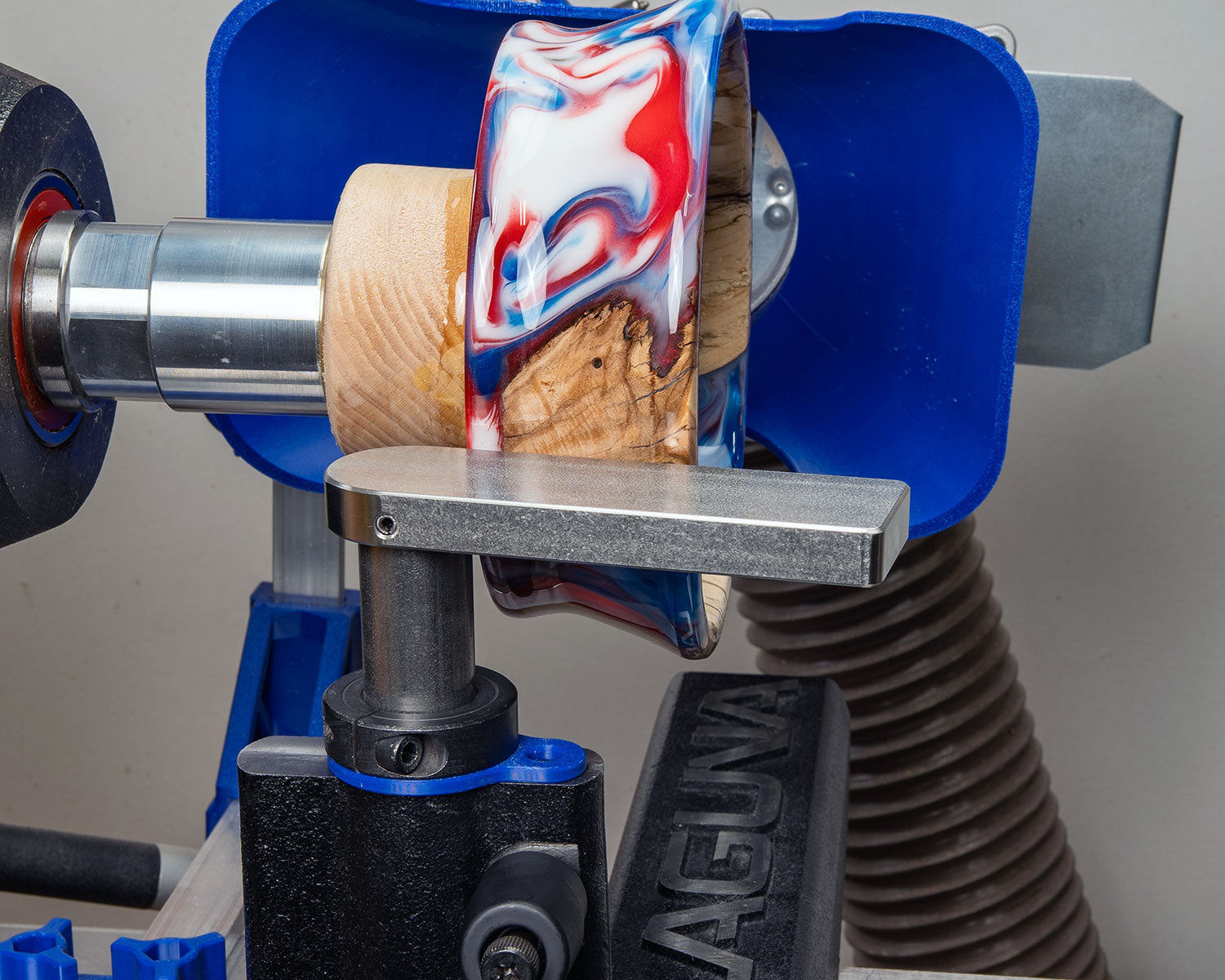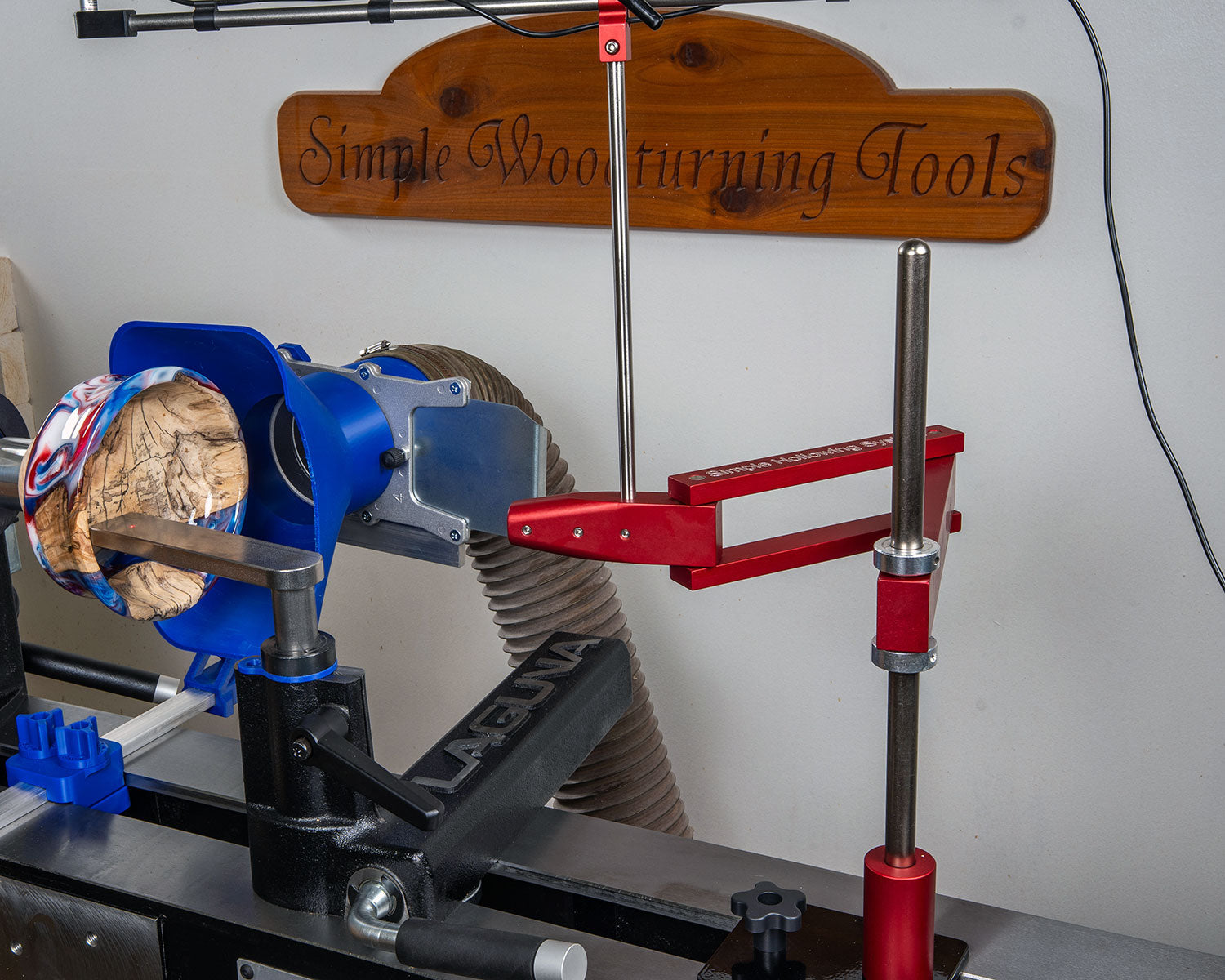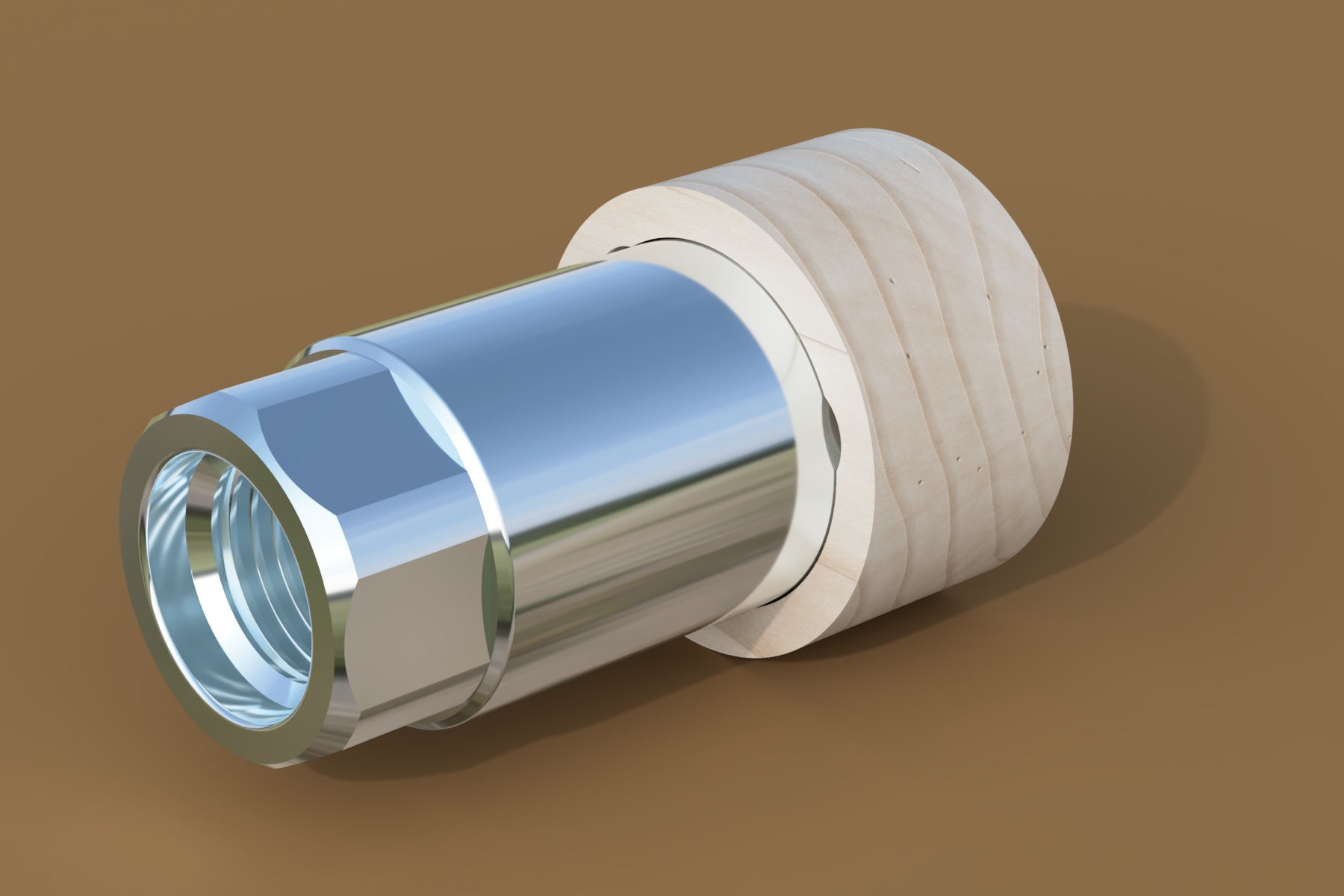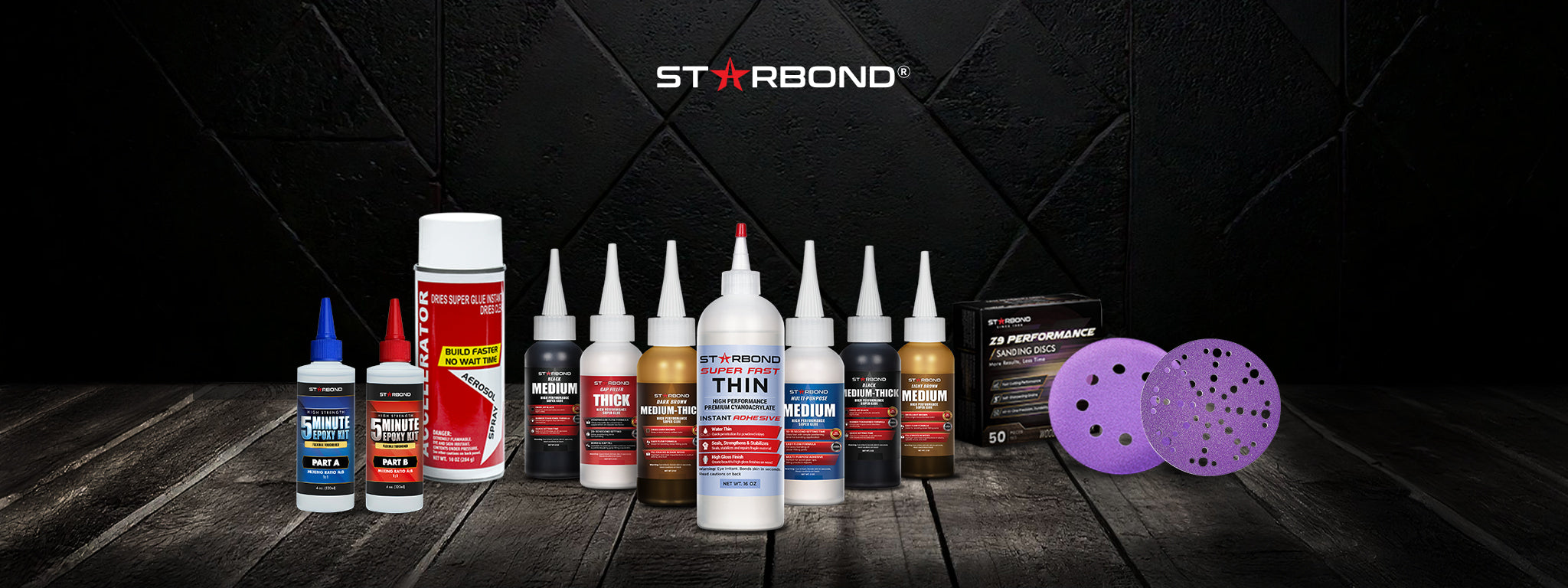Recommended Vacuum Pump
Recommended Turning Speeds
Simple Formula = “6,000 divided by Diameter” for roughing
“9,000 divided by Diameter” for finishing
• 6” bowls = a speed from 1000 to 1500 RPM.
• 5” bowls or projects = a speed from 1200 to 1800 RPM.
• 3″ stock from 2,000 to 3,000 RPM
• 2″ or smaller in diameter usually will be turned at speeds 3,000 or higher, (often at the top speed which the lathe will turn). If the lathe speed seems too high, slow it down.
All the speeds suggested are for stock which is sound, no defects or checks, and has not been laminated.
Safe turning practices are not limited to the recommendations listed above. It is your responsibility to become properly trained and educated prior to attempting woodturning.
Why do I need AR tools? and
Can I use my existing tools on resin/epoxy projects?
Since regular carbide tools did not perform well with acrylic/resin or epoxy materials, we developed a line of tools (our "AR" line) with negative rake cutters (with a special top and bottom angle) instead of the flat top carbide cutters used for wood.
The cutters on the Simple Rougher (SR), the Simple 90 Detailer (S90D) and all the Simple Scrapers (SS I and SS II) can be swapped for a negative rake cutter. The Mid Size and the Simple Start Roughers and 90 Detailers can also be swapped with negative rake cutters.
Our experience with the Simple 55 Detailer is that it works well with both wood and acrylic/resin without changing the cutter.
The Simple Turner and Hollower (STH) cutter can not be changed, so an entire new tool was created - the Acrylic Resin Simple Turner and Hollower (ARSTH) for use on acrylic/resin.
The Simple Shear Cutting Finisher® (SSCF) can be used on either wood or resin/epoxy projects. The shearing action from this cup shaped cutter works really well on acrylic/resin, hybrid or straight wood projects.
To use the Simple Shear CuttingFinisher:
1. Position the tool rest as close to the work as possible so the carbide cutter is at the lathe center line.
2. Place the tool on the tool rest with the tool shaft parallel with the floor.
3. Rotate the tool handle about its axis (similar to twisting a motorcycle throttle) approximately 35° in the direction you will be cutting.
4. While securely holding the tool slowly move the carbide cutter into the work.
5. As you begin to move the tool across the block and your project takes shape carefully rotate the tool until you find the "sweet spot" and the chips will just fly off the cutter. When you master this technique, this tool will become your favorite and you'll use it on every project.
Note: If you experience any catches or it's not cutting cleanly, it's probably due to the spindle speed being too low. If you have these issues, try speeding up the lathe.
Since not everyone enjoys changing just the cutters each time they want to turn acrylic/resin, there is a complete line of AR tools that come with the special negative rake cutters.
What's The Difference Between Full Size And Mid Size Woodturning Tools?
Full Size Tools: (recommended for turnings over 6" diameter)
- Overall Tool Length: 12"
- Handle Tang: 2.5" length x .50" diameter
- Material: 1/2" square solid stainless steel
- The SSCF tool features a 5/8" round shaft, not a square shaft.
- VIDEO: Watch here
Mid Size Tools: (recommended for turnings under 6" diameter)
- Overall Tool Length: 9"
- Handle Tang: 2" length x .375" diameter
- Material: 3/8" square solid stainless steel
- The MSSCF tool features a 3/8" round shaft, not a square shaft.
- VIDEOS: Watch here or Watch here
What does the engraving on the tools mean?
STH = Simple Turner and Hollower
S90D = Simple 90° Detailer
SR = Simple Rougher
S55D = Simple 55° Detailer
5/8" Round Shaft = Simple Shear Cutting Finisher (SSCF)
Do the Mid Size Cutters fit the Simple Start Tools?
Yes.
Are the cutter heads on the Simple Start smaller than the ones on the large tools so I can do small fine turnings?
Yes. Watch video HERE
Do other cutters fit these tools (for example Easy Wood Tools cutters)?
We have not tried cutters from other manufactures on our tools so that is unknown.
Do you have any coupons?
If there is a current coupon it will be displayed on the home page headline.
3/8 vs 1/2 bar: I have a 1220 jet lathe, and am new to turning. What do you recommend, and why?
While lathe size is important, the main consideration when selecting what size tools to purchase is more about the size of the project you will be turning than the size of the lathe. That's because small projects can be made with full size tools but large projects are difficult to make with smaller tools, even on a large lathe.
Simple Start tools with their 3/8" square x 4" length shaft and 8" length handle are very easy to use and perfect for new turners. These are intended for projects with intricate details, under 4" in turning diameter and hollowed to a max depth of 4". They are the best choice for little projects such as pens, tops, small bowls and vases, salt shakers and pepper mills, spindles, finials etc.
Mid size tools with their 3/8" square x 7" length shaft and 12" length handle are intended for projects under 6" in turned diameter and hollowed to a max depth of 6". These are intended for new and experienced turners alike who make small to mid size projects.
Full size tools with their 1/2" square x 9½" length shaft and 17" length handle are intended for projects up to 24" in turned diameter and hollowed to a max depth of 12". Although any size project can be turned with these tools, they are primarily intended for medium and large size projects.
Simple shear vs hollower, which would be best for a newbie?
The Simple Turner and Hollower (STH) is the best tool to start with because it is very simple to use. The Simple Shear Cutting Finisher (SSCF) leaves the best surface finish of any carbide turning tool but does take a bit of practice to master.
We have a Laguna 12-16 (MIDI) lathe with the bed extension. How much room will the SHS take up? Should I order the 16" or the 12" tool?
Is there a downside to turning a 12" bowl with mid size tools?
Yes, mid size tools are not stiff enough or long enough for large turnings. This will be especially noticeable during the roughing process were chatter and catches will be likely. We recommend full size tools for projects over 6" in diameter.
Can I use the foam grip handle with mid size tools?
Yes, you will just need this bushing.
Are these made in America?
Yes, in Ramsey Minnesota
Are these tools sold in stores?
No, they are only sold directly from us the manufacturer. That's how we keep the prices so low.
How large of a bowl can I hold with the vacuum chuck and do you have a larger vacuum chuck?
Because the vacuum chuck is primarily used to remove a tenon or waste block on the bottom of a turning with tail stock support the diameter of the turning makes little difference. The Live Tail Stock Chuck with Reversing Adapter is the perfect tool for this. With that chuck and the long 1/4" diameter point, or the reversing adapter, nearly the entire tenon or waste block can be turned off and the bottom finished with tail stock support. For this reason we don't sell a larger vacuum chuck.
I'm experiencing tearout - is my cutter dull? What can I do?
The cutter may be dull but before changing it try increasing the spindle speed and see if the tearout is reduced. Many times tearout is caused by a slow spindle speed, especially in soft our spalted woods.
How long do carbide tips last?
That's a really hard question to answer. Compared to HSS tools some folks say carbide tools stay sharp 100 times as long. However that really depends on what's being turned. It's similar to a carbide tipped saw blade, when cutting plywood the saw will stay sharp much longer then it would cutting hard maple. I really wish I had a good answer for this but turning wood works the same sawing it so it's very hard to say.
Are your carbide tools capable of providing the same level of smooth finishes for simple beginner spindle work such as beads and coves?
Yes carbide tools work great for spindle work and will leave a smooth finish. Just be sure to keep the spindle speed up so they cut cleanly. Plus with carbide tools it's all turning and no sharpening so you can begin turning as soon as the tools arrive.
The Simple 55° Detailer (S55D) and Simple 90° Detailer (S90D) are the best tools for beads and coves.
The Simple Rougher (SR) tool with the 6" radius cutter works very well for gently profile curves as well as straight cuts.
Finish the spindle with the Simple Shear Cutting Finisher (SSCF) because it makes very smooth shearing cuts and leaves the best surface finish of any carbide tool on the market. This tool requires a bit of practice to master but becomes a favorite because it cuts so good.
Can the Simple Hollowing System be used on a mini Lathe?
Yes. At 13 mins in this video I show how the hollowing system fits on a Rikon mini lathe. https://www.youtube.com/watch?v=QAItXRxtq6c
My detailer seems to catch when diving in, do you have any idea what I could be doing wrong? You seem to glide right in, same with the 55 degree, any suggestions would be great.
The best practice is to only cut on one side of the point as much as possible. Catches seem more likely with plunging straight into the workpiece. This causes cutting to occur on both sides of the point simultaneously. As this type of cut gets deeper the likelihood of a catch increases because the cutter and chips become trapped in a slot. To avoid this, cut on one side of the point, then the other side, widening the slot as you work your way into the project. This is a great way to remove a lot of material quickly, especially when roughing out the inside of a bowl.
Still have questions? Please send us a message and we'll get back to you!

